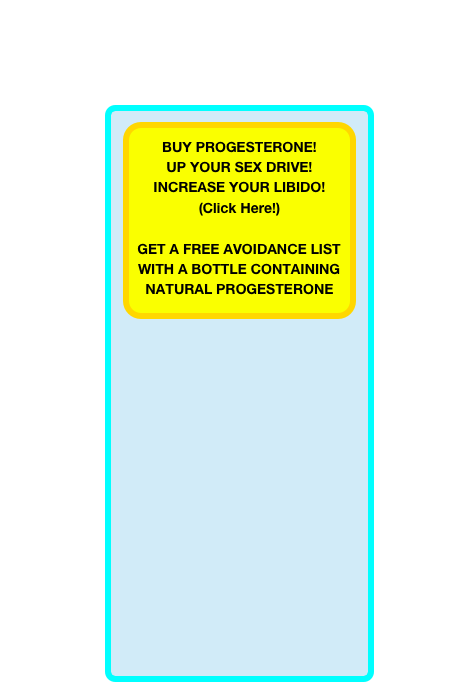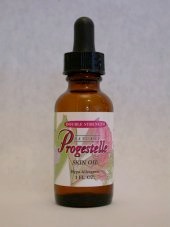

A hormone is a chemical messenger. Normally, a woman’s body produces three kinds of estrogen, estradiol, estriol and estrone. A woman also makes progesterone. “Xeno” means foreign. So Xenoestrogen means foreign estrogen. These foreign estrogens compete with your own natural estrogen for the receptor sites for estrogen. Xenoestrogens are also known as phytoestrogens (plant estrogen), environmental estrogens, chemical estrogens, endocrine disrupters and hormone disrupters. These xenoestrogens fit into the estrogen receptor and have estrogen like effects. However, the estrogen effects are NOT the same as your own estradiol. They may have very different effects from estradiol. For instance, estradiol will boost your libido, but xenoestrogens for the large part, lower libido.
Natural Progesterone can only balance out only small amounts of xenoestrogens and increase sex drive. If you have a large load of environmental estrogens, Natural Progesterone will temporarily make you worse, not better. The solution is to get rid of the xenoestrogens in your environment, THEN take progesterone.
So let’s examine some of the latest scientific evidence for xenoestrogens.
In one of the earliest experiments in the 1950’s, 2 Syracuse Biologists Lindeman and Burlington showed that DDT stopped roosters from developing into normal adult roosters. The researchers injected DDT into the rooster chicks for 2-3 months. Amazingly, the baby chicks did not get sick or die. The roosters grew up and looked like hens. The roosters testicles were 18% of normal size. The wattles and combs were stunted and pale. The DDT effectively castrated the roosters
Later, a second researcher at Unv. of California Davis injected sea gull eggs with DDE, a break down product of DDT, and methoxychlor, a second pesticide the binds to estrogen receptors. The gulls reproductive tract became female. Even the males testicles contained female cell. Some male gulls exposed to higher doses of the pesticide cocktail actually developed an oviduct. An oviduct is the egg laying tunnel that is normally present in only female gulls. But all the chicks appeared superficially to be normal.
DDT stays in the soil for several 100 years.

Fibroid Gone. Libido Boost.
I am very satisfied with the quick results I have achieved using Progestelle for the last 5 months according to your instructions for treating uterine fibroids. I was feeling much improvement after one month, and could not feel my fibroid at all after 3 months.I am not experiencing any symptoms at all at present.Thank you so much for your research and clear instructions on what lifestyle changes, supplementation, and products to avoid in addition to the Progestelle.
In addition to the Indole-3-carbinol and bioflavanoid supplementation you recommended, I have added 50 mg Butterbur extract (Solaray) daily which has completely alleviated my menstrual one sided migraine headaches that I have suffered with for over 12 years. I rarely ever have a headache now with the above combination of supplements and the Progestelle.
Thank you again for your wonderful product and professional advice. I am so very grateful not to have any more discomfort, bloating or pressure from uterine fibroids and estrogen dominance.
One major improvement I forgot to mention was that my non-existent sex drive returned. within just a few weeks of starting the Progestelle. This was a pleasant surprise.
Sincerely,
Deborah E., Lafayette, CO

The research for BPA being a hormone disrupter is overwhelming. In 2008, Canada banned BPA for use in plastic bottles baby botles. And Wal-Mart volunteered to pull them off the shelf for sale even in the USA despite assurances from the FDA that the bottles posed no threat.
Recently in Oct. 2011, the Harvard School of Health found that high BPA levels in pregnant mothers were correlated with girls’ behaviors of hyperactivity, anxiety, and depression. The study was published in the journal Pediatrics. Similar results came from other animal studies suggesting that BPA impacts brain development in monkeys and rodents.
BPA is known to be an endocrine disrupter. This means that BPA interferes with how hormones, chemical signals, work in the body. When the signals are blocked or changed, organs and in this case the brain may not develop normally.
The FDA has recently changed its tune in 2010, stating that, “FDA shares the perspective of the National Toxicology Program that recent studies provide reason for some concern about the potential effect of BPA on the brain, behavior, and prostate gland of fetuses, infants, and children.”
If you look at the chemical formula for hormone disrupters they usually contain a benzene ring or phenyl group. A synonym in organic chemistry for benzene rings is “aromatics”. Anything that is fragrant usually contains these. These rings usually fit into the estrogen receptor.
What does "fresh" mean to an air freshener? Natural Resources Defense Council (NRDC) looked at 14 air fresheners from the shelf of a local Walgreens. The NRDC found 12 air fresheners had varying amounts of substances called phthalates (pronounced THAL-ates). Pthalates are class of chemicals used as solvents to carry fragrances, soften plastics and also as sealants and adhesives. Phthalates are ubiquitous in cosmetics, paints, nail polish and children's toys. Pthalates have been the villain in a larger international controversy over their health effects.
Scientific studies with rats and humans suggest that high exposures to certain kinds of phthalates cause cancer, developmental and sex-hormone abnormalities (including decreased testosterone and sperm levels and malformed sex organs) in infants, and can affect fertility. [Pthalates may also cause a low libido.]
The U.S. Food and Drug Administration does not have any rules on the use of phthalates. The FDA is silent the labeling of phthalate content on products. The FDA does not consider the quantities of pthalates to which people are exposed to be of any harm. But other countries differ. The European Union banned two types of phthalates in cosmetics and bans the pthalates in children's toys in 2004, ditto in 14 other countries. California banned pthalates in Jan. of 2009. In Feb. of 2009, the US banned pthalates in children's’ toys.
Here is a quote from the FDA website:
At the present time, FDA does not have compelling evidence that phthalates, as used in cosmetics, pose a safety risk.
Under the authority of the Fair Packaging and Labeling Act (FPLA), FDA requires an ingredient declaration on the cosmetic products sold at the retail level to consumers. Consumers can tell whether some products contain phthalates by reading the ingredient declaration on the labels of such products.
However, the regulations do not require the listing of the individual fragrance ingredients; therefore, the consumer will not be able to determine from the ingredient declaration if phthalates are present in a fragrance. Also, because the FPLA does not apply to products used exclusively by professionals--for example, in salons--the requirement for an ingredient declaration does not apply to these products.
75% of U.S. households use plug-in, spray or stand-alone liquid and gel air fresheners. In 2009, the market in the USA was $1.5 billion. The NRDC tested products, including those labeled "all-natural" or "unscented," and found a wide range of phthalate content, from zero parts per million (ppm) to 7,300 ppm. Many air fresheners had a phthalate known as DEP. Some also contained DBP. Both chemicals are classified by the California EPA's Office of Environmental Health Hazard Assessment as a developmental toxin and female and male reproductive toxin, respectively.
So you wonder why you have low libido? Pthalates is a another chemical for the villain list. Get a clue. The innocuous perfume or air freshener you just bought may be bad for you. How can it be good for you? It can’t be good for you. It may be give you a low libido
Sumpter in Brunel University investigated male fish that looked female reported by fisherman in English Rivers. Fish caught below the discharge of sewage plants looked both male and female at the same time to veteran fishermen. They were hemaphrodite fish.
A protein called vitellogenin, a special egg protein, is normally only found in female fish. Estrogen signals the normal female fish body to produce vitellogenin. Normally male fish do not have vitellogen.
Fish raised in captivity were then place in cages and pools below the sewage treatment plants. These polluted fish produced 1000 to 100,000 more vitellogenin than control trout kept in clean water.
Alkyphenols from detergent breakdown products are suspect in feminizing fish.
Male fish held in an aquarium with small amounts of laundry detergent grew up looking female.
In 2004, retired fisheries biologist Woodling discovered freak 1/2 male and 1/2 female fish just below sewage treatment plants in Denver and Boulder, Colorado. Fish above the treated sewage outlet were normal with half the population being male and half the population female. However, below the sewage outfall, the ratio was 10 females to 1 male and 1 hemaphrodite fish. Above the sewage outfall the female to male ratio was 1 to 1 with no hemaphrodite fish.
Eventually people drink this water.
Not Good.
Eventually the US Geological Survey found fish feminization in all the major water sheds in the US. It can’t be good for you. How can that be good for your sex drive?
READ about USGS most recent research here.
Can the wrong laundry detergent give you a low sex drive? My patients that use the wrong laundry detergent have increased bloating and breast tenderness and complain of decreased libido. I can trace on some of my patients that changing to the right laundry detergent decreases their bloating and breast tenderness and this is correlated to INCREASED libido boost.
Margaret Schlumpf [1] from the Institute of Pharmacology and Toxicology, University of Zurich, Switzerland found that many of the ingredients in sunscreen are endocrine disrupters. Five of six common sunscreens used frequently in lipsticks, sunscreens, and cosmetics acted like strong estrogen. They made cancer cells grow more. These were benzophenone-3, homosalate, 4-methyl-benzylidene camphor (4-MBC), octyl-methoxycinnamate and octyl-dimethyl-PABA. Only one of these sunscreen chemicals showed no activity, butyl-methoxydibenzoylmethane (B-MDM) with the cancer cells. A frequently used chemical in sunscreens 4-MBC mixed with olive oil was applied to rat skin. It doubled uterine growth when used well before puberty. Concentrations of 4-MBC were used that were the same as used in sunscreens. 3 of 6 chemicals caused developmental abnormalities in animals.
Can low libido be caused by some ingredients in sunscreen? I am not certain. But how can it be good for your sexual desire?
Zinc oxide in oil is a better choice. This is a simple choice.
-
1. Schlumpf , Margaret; Beata Cotton, Marianne Conscience, Vreni Haller, Beate Steinmann, Walter Lichtensteiger.In vitro and in vivo estrogenicity of UV screens.”Environmental Health Perspectives Vol. 109 (March 2001) pp 239-244
More about environmental estrogens and bioidentical progesterone, and low sexual desire.





















